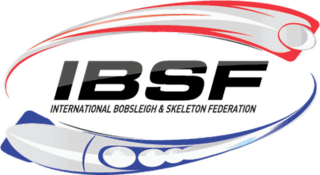
Bobsleigh or bobsled is a winter sport in which teams of 2 to 4 athletes make timed runs down narrow, twisting, banked, iced tracks in a gravity-powered sleigh. International bobsleigh competitions are governed by the International Bobsleigh and Skeleton Federation.
At the 1948 Winter Olympics, two bobsleigh events were contested. The two-man competition was held on Friday, January 30, 1948 and on Saturday, January 31, 1948 while the four-man competition was held on Friday, February 6, 1948 and on Saturday, February 7, 1948.

Thomas Lamparter is a Swiss former bobsledder who has competed since 2002. Competing in three Winter Olympics, he won a bronze medal in the four-man event at Turin in 2006 as part of the crew of Martin Annen.

The International Bobsleigh and Skeleton Federation (IBSF) is the international sports federation for the sliding sports of Bobsleigh and Skeleton. It was founded on 23 November 1923 by the delegates of Great Britain, France, Switzerland, Canada, and the United States at the meeting of their first International Congress in Paris, France. In June 2015, it announced a name change from FIBT to IBSF. The federation's headquarters are in Lausanne, Switzerland.
The FIBT World Championships 1982 took place in St. Moritz, Switzerland for the record fourteenth time. The Swiss city had hosted the event previously in 1931 (Four-man), 1935 (Four-man), 1937 (Four-man), 1938 (Two-man), 1939 (Two-man), 1947, 1955, 1957, 1959, 1965, 1970, 1974, and 1977. The skeleton event debuted at the championships after being held in St. Moritz at the 1928 and 1948 Winter Olympics and it marked the first time the event took place on the actual bobsleigh track and not on the Cresta Run.
The FIBT World Championships 1990 took place in St. Moritz, Switzerland (Bobsleigh) and Königssee, West Germany (Skeleton). St. Moritz hosted a championship event for the record seventeenth time. The Swiss city had hosted the event previously in 1931 (Four-man), 1935 (Four-man), 1937 (Four-man), 1938 (Two-man), 1939 (Two-man), 1947, 1955, 1957, 1959, 1965, 1970, 1974, 1977, 1982, 1987, and 1989 (Skeleton). Meanwhile, Königssee hosted a championship event for the third time, doing so previously in 1979 and 1986.
William John D'Amico was an American bobsledder who competed in the late 1940s and early 1950s. He won a gold medal in the four-man event at the 1948 Winter Olympics in St. Moritz.

Max Houben was a Belgian versatile athlete who competed from the early 1920s until his death at the 1949 FIBT World Championships. He won a silver medal in the four-man bobsled event at the 1948 Winter Olympics in St. Moritz, and was the oldest medalist at the Winter Olympics until Canadian Russ Howard won a gold medal in men's curling at the 2006 Winter Olympics in Turin.
Jacques Mouvet was a Belgian bobsledder. He won a silver medal in the four-man event at the 1948 Winter Olympics in St. Moritz and finished fourth in the two-man event at those same games. Mouvet also earned two medals at the 1947 FIBT World Championships in St. Moritz with a silver in the four-man and a bronze in the two-man event.
James John Bickford was an American bobsledder who competed from the late 1930s to the mid-1950s. Competing in four Winter Olympics, he won a bronze medal in the four-man event at St. Moritz in 1948.
William Francis Dupree, from Saranac Lake, New York, was an American bobsledder who competed from the late 1930s to the late 1940s. He won a bronze medal in the four-man event at the 1948 Winter Olympics in St. Moritz.
Felix Endrich was a Swiss bobsledder who competed in the late 1940s and early 1950s. Competing in two Winter Olympics, he won the gold medal along with brakeman Fritz Waller in the two-man event at the 1948 Winter Olympics in St. Moritz.
Friedrich "Fritz" Waller was a Swiss bobsledder who competed in the late 1940s. He won the gold medal in the two-man event at the 1948 Winter Olympics in St. Moritz.
Henri Achille Fould was a French bobsledder who competed in the late 1940s. He won a bronze medal in the four-man event at the 1947 FIBT World Championships in St. Moritz.
William Gayraud-Hirigoyen was a French athlete who competed in rugby union in the late 1910s and early 1920s, then moved to bobsleigh and skeleton in the late 1940s.
René Henri Theophile Lunden, Baron de Lunden was a Belgian bobsledder who competed in the late 1930s. He won a gold medal in the two-man event at the 1939 FIBT World Championships in St. Moritz.
Karl Häseli is a Swiss bobsledder and track and field athlete who competed in the mid-1970s.
The FIBT World Championships 2013 took place at the St. Moritz-Celerina Olympic Bobrun in St. Moritz, Switzerland, for the record twenty-second time, after hosting the event previously in 1931 (Four-man), 1935 (Four-man), 1937 (Four-man), 1938 (Two-man), 1939 (Two-man), 1947, 1955, 1957, 1959, 1965, 1970, 1974, 1977, 1982, 1987, 1989 (Skeleton), 1990 (Bobsleigh), 1997 (Bobsleigh), 1998 (Skeleton), 2001, and 2007.
For the 1928 Winter Olympics in St. Moritz, Switzerland, a total of five sports venues were used. The main stadium hosted the figure skating, ice hockey, and speed skating events. Skeleton was first held at the Cresta Run. Bobsleigh was held at the bob run. St. Moritz itself served as cross-country skiing venue and the cross-country part of the Nordic combined event. Weather gave two events run at these games problems, creating the largest margin of victory in Olympic history for one and the cancellation of the other.
For the 1948 Winter Olympics in St. Moritz, Switzerland, a total of eight sports venues were used. The five venues used for the 1928 Winter Olympics were reused for these games. Three new venues were added for alpine skiing which had been added to the Winter Olympics program twelve years earlier in Garmisch-Partenkirchen, Germany. As of 2015, the bob run continues to be used for bobsleigh and the Cresta Run for skeleton while alpine skiing remains popular in St. Moritz.



